Explore the best free graphic design tools of 2023! From Figma’s collaboration to Krita’s artistry, find your perfect software match.
2023 offers a wide array of free graphic design software, each with its strengths. This article cuts through the clutter to present the best free tools available, evaluating them for features, performance, and user experience. Whether you’re a pro or just starting out, we’ve covered you with top picks that won’t cost you a dime.
Table of contents
- Best free graphic design tools
- Best free graphic tools for social media
- Best free tools for motion design
- Honorable mentions
- Comparison of tools
Best free graphic design tools
Figma
Platform: online, macOS, Windows
Pricing: Free | Professional plan starts at $12/month

Figma revolutionizes collaborative design with its cloud-based platform, allowing teams to work together seamlessly. It’s a one-stop solution for UI/UX design, offering vector tools and prototyping features. The interface is clean and intuitive, making it accessible for designers of all skill levels. Its real-time collaboration capability sets it apart, making it a favorite in the design community.
Feature set:
- Real-time collaboration tools for team projects.
- Extensive library, including fonts, color schemes, and customizable templates.
- Supports a wide range of projects, from social media graphics to 3D designs.
Downsides:
- Requires a stable internet connection.
- May not offer some advanced features found in more specialized software.
Performance:
- Smooth and responsive across various platforms.
- Efficient even with complex designs, thanks to its optimized browser version.
Overall impression:
Figma is a boon for graphic design professionals and enthusiasts alike. Its mix of user-friendly interface, variety of file formats, and collaborative features make it a top choice in the free graphic design tools landscape.
Lunacy
Platform: macOS, Windows, Linux
Pricing: 100% Free

Lunacy sets itself apart as a cross-platform graphic design tool, offering robust features for Windows, Mac, and Linux users. It’s a versatile app, great for UI/UX design, with tools for vector graphics, icons, and photo editing. The intuitive interface and AI-powered assets make it accessible for designers of all levels. Its compatibility across platforms and native performance on each make Lunacy a strong option for diverse design workflows.
Feature set:
- Features advanced tools, including AI-powered features and sophisticated vector graphics capabilities.
- Offers a rich library of assets, blend modes, and brush tools suitable for both vector and raster graphics.
- Supports a variety of file formats, catering to diverse graphic design projects.
Downsides:
- The interface, while customizable, might present a steep learning curve for beginners.
Performance:
- Shows high efficiency and stability across all supported platforms.
- Handles complex designs and 3D graphics with ease, showcasing its power as a professional tool.
Overall impression:
Lunacy strikes a fine balance with its user-friendly interface and array of sophisticated tools. Its cross-platform availability and extensive design assets make it a strong contender for both new and seasoned graphic design professionals.
Linearity (ex-Vectornator)
Planform: iOS, iPadOS, and macOS
Pricing: Free | Pro subscription starts at $9.99/month
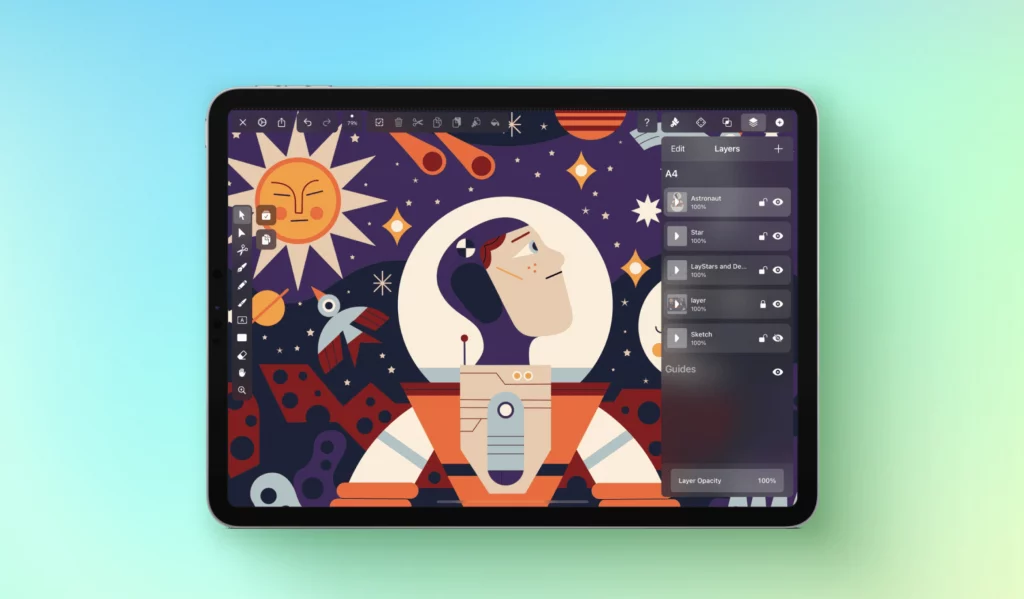
Linearity, known for its vector graphics prowess, offers an intuitive interface with advanced drawing tools. Its focus on precision and ease of use makes it a go-to for vector art and illustrations. The app’s lightweight design ensures smooth performance, even on less powerful machines. Linearity is a favorite among designers who prioritize clean, scalable vector artwork.
Feature Set:
- Specializes in vector art with an intuitive interface and powerful pen tool.
- Offers an extensive library of vector elements and pre-made templates.
- Supports various file formats, enhancing its versatility for different design projects.
Downsides:
- May lack some advanced 3D tools and features in more comprehensive 3D software.
- Its focus on vector art means raster graphics are not its strong suit.
Performance:
- Known for its smooth performance, particularly in creating detailed vector art.
- Efficient and responsive, making it a solid choice for both beginner and advanced users.
Overall impression:
Linearity stands out in vector graphics with its user-friendly interface and precision tools. It’s an excellent choice for designers prioritizing clean, precise vector work, though those needing more complex tools might look elsewhere.
Krita
Platform: Linux, macOS, Windows
Pricing: 100% free
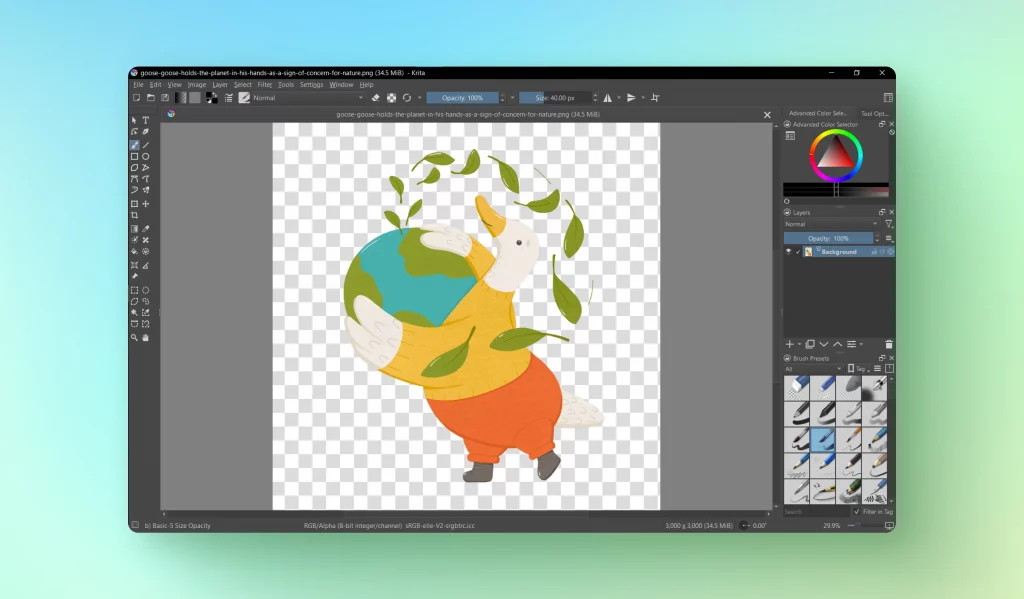
Krita is a powerful open-source tool, primarily geared towards digital artists and illustrators. It excels in digital painting, offering a wide array of brush tools and texture options. The software also supports animation, making it a versatile choice for creators. Krita’s focus on artistic creation makes it a top choice for digital painters and illustrators seeking a comprehensive and free tool.
Feature set:
- Boasts a comprehensive set of brush tools and color schemes, perfect for digital painting.
- Includes advanced features like layer management, blend modes, and custom brush creation.
- Supports a variety of file formats, making it versatile for different artistic projects.
Downsides:
- While powerful for digital painting, it may not be the first choice for typical vector graphic design or photo editing tasks.
- The interface and plethora of features can be overwhelming for beginners.
Performance:
- Offers robust performance, especially in handling high-resolution digital paintings and complex layering.
- Its open-source nature means a continuously evolving and improving platform supported by an active community.
Overall impression:
Krita excels in digital painting and illustration, offering a range of sophisticated tools for creative expression. It’s a fantastic option for artists, though graphic designers focusing on other areas might find it less aligned with their needs.
Best free graphic tools for social media
Adobe Express
Platform: online
Pricing: Free | Paid version starts at $9.99/month
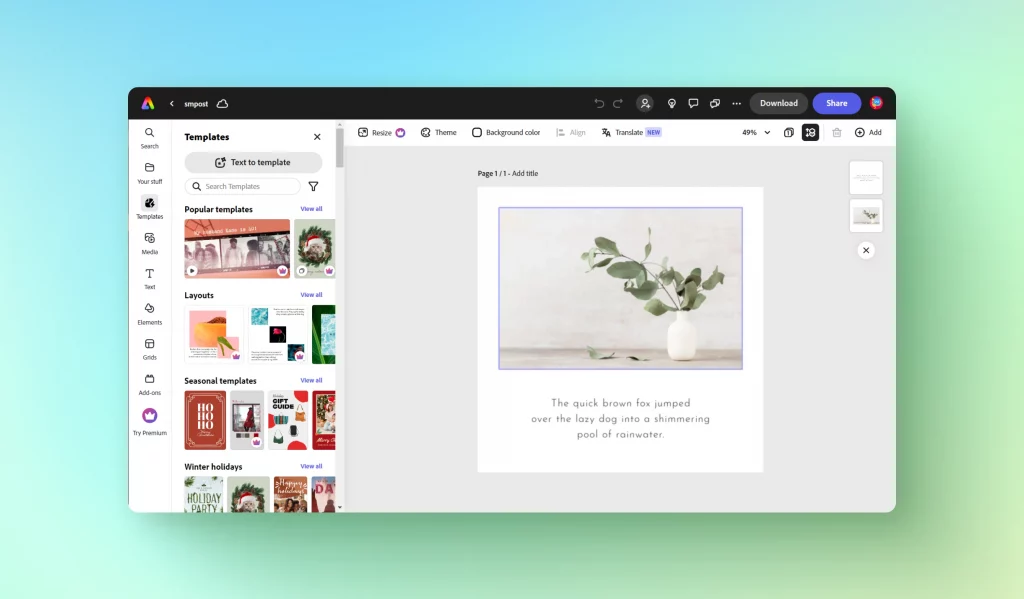
Adobe Express is a web-based tool, perfect for quick, template-driven design work. It simplifies the design process with a vast array of customizable templates and easy-to-use layout options. Aimed at non-designers and professionals alike, it makes creating polished graphics and web content incredibly accessible. Its integration with Adobe’s ecosystem adds value for those already in the Adobe universe.
Feature set:
- Offers an array of customizable templates, design assets, and easy-to-use color palette tools.
- Ideal for creating pre-designed templates and ready-made templates for fast turnarounds.
- Integrates stock images and design resources, simplifying the design process.
Downsides:
- Limited in advanced editing features, making it less suitable for complex graphic design projects.
- Some users may find the customization options lacking compared to more sophisticated tools.
Performance:
- As an online tool, it’s highly accessible and performs consistently well in a browser version.
- Efficient for quick edits and smaller projects, but might not be the best choice for heavy-duty graphic design work.
Overall impression:
Adobe Express excels as a user-friendly interface for quick and professional designs. Its focus on simplicity and speed makes it ideal for beginners and those needing to produce quality designs with minimal fuss.
Canva
Platform: online
Pricing: Free | Pro Plan starts at $29.99/mo
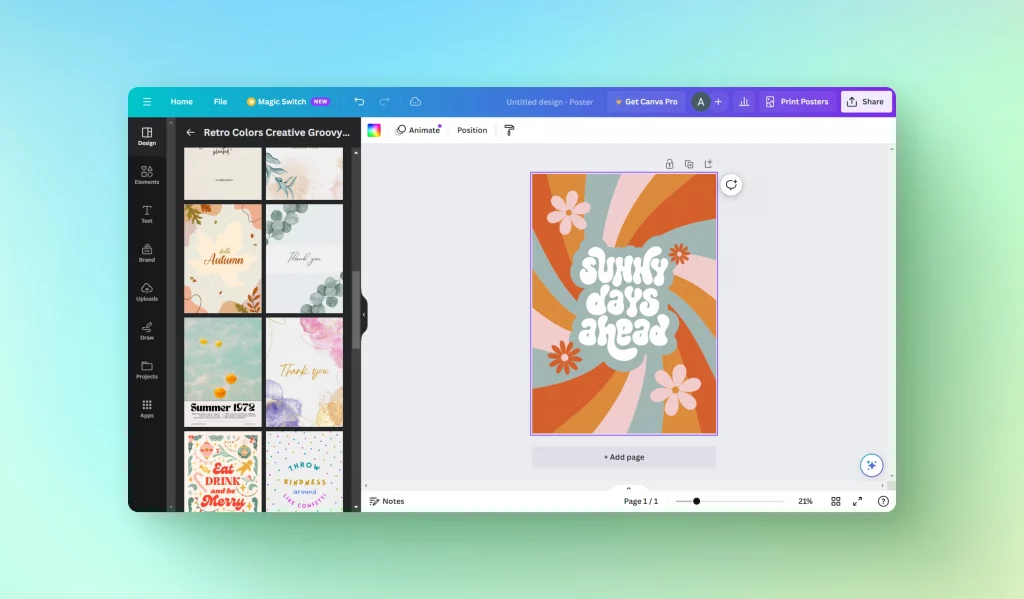
Canva has become synonymous with user-friendly graphic design, catering to both beginners and seasoned designers. Its drag-and-drop interface and vast library of templates make design accessible to everyone. Canva is particularly strong in creating social media content, presentations, and marketing materials. The platform’s continual updates and addition of new features keep it at the forefront of online design tools.
Feature set:
- Rich in customizable templates, design assets, and an expansive color palette.
- Offers a wide variety of file formats, suitable for everything from social media graphics to professional presentations.
- User-friendly interface makes it accessible to users of all skill levels.
Downsides:
- While versatile, it might lack the depth in advanced features desired by professional designers.
- Some users might find its templates and design elements a bit generic.
Performance:
- Known for its robust performance, especially in creating quick, visually appealing designs.
- Works smoothly across various platforms, including its browser and desktop app versions.
Overall impression:
Canva is a powerhouse for creating professional designs with minimal effort. It’s ideal for those who value speed and ease of use, though advanced designers might miss the complexity of more sophisticated tools.
DesignWizard
Platform: online
Pricing: Free | Subscription starts at 9.99/month
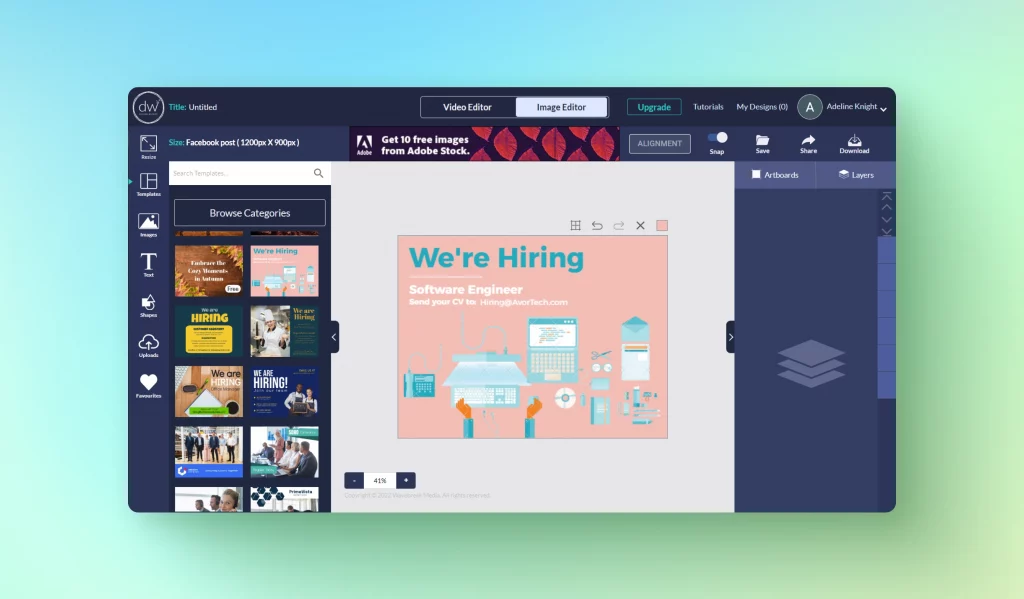
DesignWizard stands out for its ease of use in creating high-quality digital content quickly. It offers a wide range of customizable templates, making it perfect for social media, marketing materials, and more. The tool is designed for users who need to produce visually appealing content with minimal design experience. Its library of images and graphics provides a solid foundation for creative projects.
Feature set:
- Offers a wide range of customizable templates and design elements for quick creation.
- Equipped with an extensive library of stock images and pre-made templates, ideal for rapid design projects.
- Intuitive interface makes it easy for users to create stunning designs with minimal effort.
Downsides:
- Advanced users may find the tool’s capabilities limited for sophisticated design tasks.
- Some features, especially more advanced tools, might be locked behind a paywall.
Performance:
- Performs consistently well, particularly for online design tasks and quick edits.
- Optimized for ease of use, allowing for efficient design creation.
Overall impression:
DesignWizard is a strong contender for those needing quick, attractive designs without a steep learning curve. It’s particularly effective for marketers and content creators, though professional designers might crave more complex features.
Best free tools for motion design
Blender
Platform: Windows, macOS, Linux
Pricing: 100% free
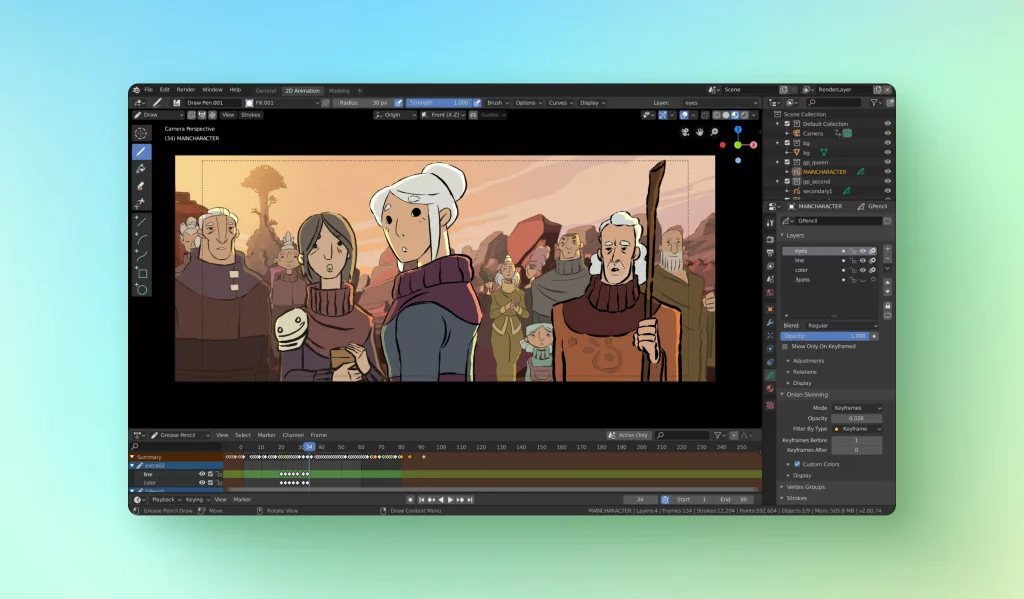
Blender is a powerhouse in the world of free 3D graphics software, offering an all-in-one solution for 3D modeling, animation, and rendering. Known for its complex tools and sophisticated features, it caters to professionals in animation, game development, and visual effects. Despite its steep learning curve, Blender’s comprehensive toolset – from sculpting to motion tracking – makes it a favorite among 3D artists. Its open-source nature not only makes it accessible but also ensures continual improvements and a strong community support system.
Feature set:
- Offers robust capabilities in 3D modeling, rigging, animation, and simulation.
- Includes advanced features like sculpting, texturing, and node-based material creation.
- Supports a wide range of file formats, enhancing its versatility in 3D projects.
Downsides:
- The extensive range of features results in a steep learning curve.
- Its interface can overwhelm newcomers and those accustomed to more streamlined 3D tools.
Performance:
- Delivers powerful performance, particularly in complex 3D modeling and animation tasks.
- Can be resource-intensive, requiring a decent hardware setup for optimal operation.
Overall impression:
Blender is a top-tier choice for professionals in 3D design and animation. While its complexity may deter beginners, its capabilities are unmatched in the free software realm, making it a go-to for serious 3D projects.
Synfig
Platform: Windows, OS X, Linux
Pricing: 100% free

Synfig specializes in 2D animation, offering a suite of tools for creating detailed and fluid animations. It’s an open-source platform, making it an appealing choice for those on a budget. The software includes features like bone rigging and vector tweening, essential for professional-grade animations. Synfig is ideal for animators looking to dive into the complexities of 2D animation without financial constraints.
Feature set:
- Specializes in 2D vector graphics and animation, with a robust set of tools for intricate motion work.
- Includes advanced features like bone rigging and vector tweening, catering to more sophisticated animation projects.
- Supports a wide range of file formats, enhancing its utility in various animation contexts.
Downsides:
- The interface and workflow can present a steep learning curve, especially for beginners.
- Might not be the first choice for those seeking simple graphic design tools for static images.
Performance:
- Delivers solid performance in animation rendering, though it can be resource-intensive on older machines.
- Capable of handling complex animations with its sophisticated tools, appealing to advanced users.
Overall impression:
Synfig is a powerful choice for those delving into the world of 2D animation. While its complexity might intimidate new users, it’s a boon for animators seeking advanced capabilities without the cost.
LottieLab
Platform: online
Pricing: 100% free
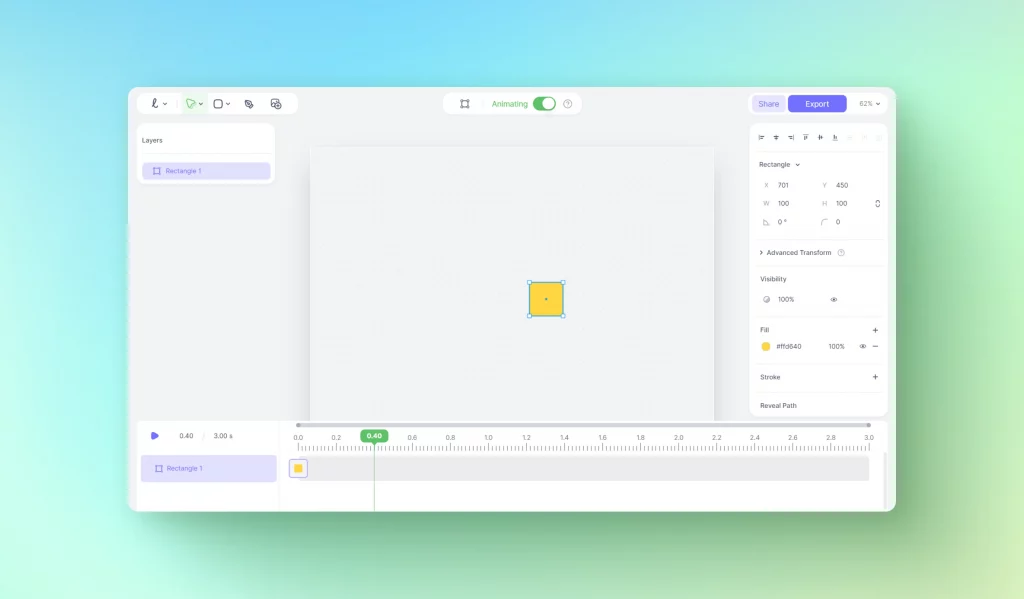
LottieLab is a specialized tool focusing on creating and editing Lottie animations, a popular web animation format. It’s designed for designers and developers looking to integrate animations into their digital products. The interface is straightforward, catering to both beginners and experienced animators. LottieLab fills a unique niche, providing essential tools for modern web-based animation work.
Feature set:
- Specializes in Lottie file creation and editing, offering a unique niche in animation design.
- User-friendly interface allows for easy manipulation of animation elements.
- Integrates advanced features for refining animations, suitable for web and mobile applications.
Downsides:
- Its specialization in Lottie animations means it’s not a one-stop shop for all graphic design needs.
- May require some background knowledge of animation basics for optimal use.
Performance:
- Efficient and reliable in creating and editing Lottie’s animations.
- Well-suited for designers looking to integrate animations into their digital products.
Overall impression:
LottieLab is a standout choice for designers venturing into the world of Lottie animations. Its focused approach makes it invaluable for specific animation tasks, though those seeking broader graphic design capabilities might need additional tools.
Honorable mentions
Haikei
Platform: online
Pricing: 100% free

Haikei stands out with its unique approach, combining traditional design elements with AI-powered capabilities. It’s designed for designers looking to experiment and push the boundaries of graphic design. The tool excels in creating abstract patterns, gradients, and shapes, adding a modern twist to design projects. Haikei is ideal for creatives seeking to blend AI innovation with graphic design.
Feature set:
- Offers AI-powered features, allowing for innovative and unique design creations.
- Boasts a variety of tools for creating graphic elements, from sophisticated patterns to dynamic shapes.
- Its intuitive interface makes it accessible for creating complex tools like gradient meshes and SVG shapes.
Downsides:
- May not cater to those seeking traditional graphic design elements or extensive template libraries.
- Its unique approach might require a period of adaptation, especially for those accustomed to more conventional design software.
Performance:
- Performs efficiently, particularly in generating custom graphics and elements.
- Its streamlined process is advantageous for designers experimenting with new ideas and concepts.
Overall impression:
Haikei is a fresh breath in graphic design, perfect for designers looking to push creative boundaries with AI-powered tools. While it may not replace traditional design software, it is a powerful complement to innovative design tasks.
Screely
Platform: online
Pricing: 100% free
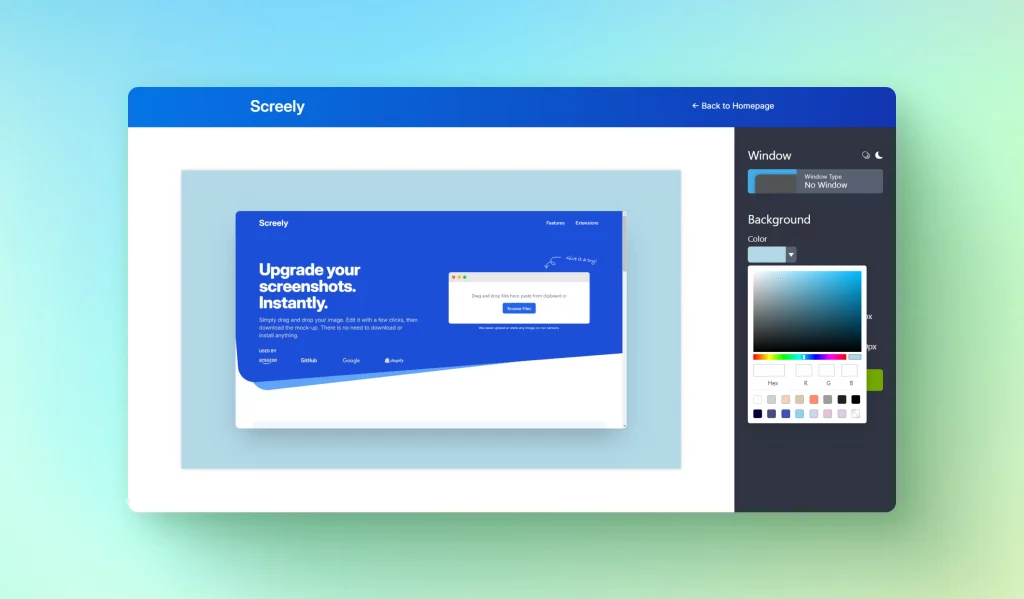
Screely offers a niche solution for quickly turning screenshots into presentable and clean graphics. It’s a straightforward tool, perfect for enhancing visuals for presentations or web content. With minimal design features, it focuses on simplicity and speed, rather than complexity. Screely is ideal for anyone needing to polish screen captures with a professional touch.
Feature set:
- Ideal for quickly beautifying screenshots with minimal effort.
- Provides basic editing features, like adding backgrounds and simple graphic elements.
- A straightforward tool for enhancing visuals, particularly for presentations or social media content.
Downsides:
- Limited in scope, it’s not a comprehensive graphic design tool for complex projects.
- Lacks advanced editing features and customizable templates found in more versatile graphic design software.
Performance:
- Known for its quick and efficient operation, making it great for speedy edits.
- Performs reliably for its intended use, but won’t replace more sophisticated design apps.
Overall impression:
Screely is a handy tool for a specific need – enhancing screenshots. It’s incredibly user-friendly and efficient for its purpose, but those needing a full suite of design features will need to look elsewhere.
Comparison of tools
| Criteria/Tool | Figma | Lunacy | Krita | Linearity | Adobe Express | Canva |
| Collaborative features | ✅ | ✅ | ✅ | ✅ | ❌ | ✅ |
| Vector graphics capabilities | ✅ | ✅ | ✅ | ✅ | ❌ | ✅ |
| Raster graphics capabilities | ❌ | ✅ | ❌ | ❌ | ❌ | ❌ |
| Template variety | ✅ | ❌ | ❌ | ❌ | ✅ | ✅ |
| Ease of use | ✅ | ✅ | ✅ | ✅ | ✅ | ✅ |
| AI features | ❌ | ✅ | ❌ | ❌ | ❌ | ✅ |
| Platform availability | All | All | All | iPadOS, iOS | Web | Web |
| Rating | 4.5 | 5.0 | 4.5 | 4.5 | 3.0 | 4.5 |
- Collaboration and interface: Figma leads in collaborative design with its real-time editing and version history capabilities, essential for team-based projects. Its interface balances intuitiveness with advanced features, a boon for professional workflows.
- Vector and raster graphics: Lunacy and Linearity excel in vector graphics, offering sophisticated tools like the pen tool and advanced vector handling. Krita, on the other hand, is a powerhouse for raster graphics, especially digital painting, with its extensive brush tools and blend modes.
- Animation and specialized design: Synfig offers bone rigging and vector tweening, key for intricate 2D animations, while LottieLab specializes in Lottie animations, filling a specific niche in web-based motion graphics.
- Template-driven design: Canva and Adobe Express are the go-to for quick, template-driven designs. They offer a huge library of pre-designed templates and easy-to-use drag-and-drop features, ideal for rapid content creation.
- AI integration and innovation: Haikei stands out with its AI-powered tools, catering to designers who want to experiment with AI-assisted design elements, pushing the envelope of traditional graphic design.
- Accessibility and ease of use: DesignWizard and Screely offer a streamlined approach to design, with Screely being particularly adept at quickly enhancing screenshots. Their simplicity, however, trades off with the depth of features.
Each tool has its strengths, catering to different aspects of graphic design – from collaborative projects to specialized design tasks. Understanding these nuances is key in selecting the right tool for your design needs.
Wrapping up, 2023’s best free graphic design software are more about choice and less about compromise. Whether it’s Figma for team collaboration, Krita for digital art, or Canva for quick designs, there’s a tool for every designer’s toolkit. Your pick should resonate with your project’s demands and your design chops. Dive in, test them out, and gear up your design game without spending a penny.
Check out our list of the best vector design software in 2023 tested by our team.